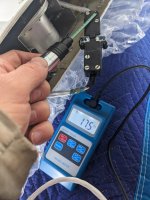Hi all,
I've been getting weird behavior from GMU22 lately, and would love any advice on how to debug this.
The setup is G3X Touch + GMU22 and a G5 (in a Lancair). At some point last year we started seeing frequent heading swings and heading divergence warning with G3X differing by 10-20 degrees from G5. The problem was likely in the G3X side of things, because sometimes we could see that the synthetic vision picture was significantly rotated compared to the outside.
We did the G3X magnetic disturbance test and it came back at ~8%. After that we did a calibration and heading disagreement warnings disappeared. Instead we started getting intermittent "AHRS magnetic anomaly" warnings.
After we upgraded G3X Touch to the latest software the warnings disappeared for a bit. They are now back. They are pretty rare, don't last long and don't seem to be correlated with anything in particular, so I'm at a loss for how to debug this. G5 and G3X headings seem to be the same (within 1-2 degrees).
Do they show up in any G3X logs? Is there a way to figure out what kind of anomaly the magnetometer senses?
I've been getting weird behavior from GMU22 lately, and would love any advice on how to debug this.
The setup is G3X Touch + GMU22 and a G5 (in a Lancair). At some point last year we started seeing frequent heading swings and heading divergence warning with G3X differing by 10-20 degrees from G5. The problem was likely in the G3X side of things, because sometimes we could see that the synthetic vision picture was significantly rotated compared to the outside.
We did the G3X magnetic disturbance test and it came back at ~8%. After that we did a calibration and heading disagreement warnings disappeared. Instead we started getting intermittent "AHRS magnetic anomaly" warnings.
After we upgraded G3X Touch to the latest software the warnings disappeared for a bit. They are now back. They are pretty rare, don't last long and don't seem to be correlated with anything in particular, so I'm at a loss for how to debug this. G5 and G3X headings seem to be the same (within 1-2 degrees).
Do they show up in any G3X logs? Is there a way to figure out what kind of anomaly the magnetometer senses?





